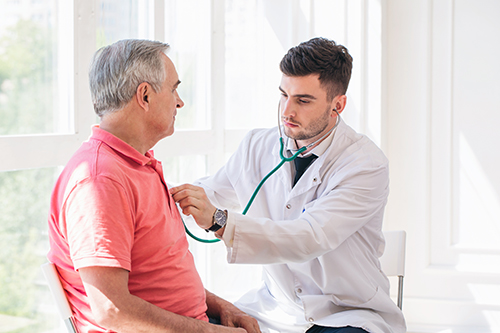WHAT IS CHRONIC OBSTRUCTIVE PULMONARY DISEASE?
Chronic Obstructive Pulmonary Disease, also known as COPD, is a general term which refers to a group of lung disorders characterized by chronic inflammation that causes obstructed airflow from the lungs. Emphysema and chronic bronchitis are examples of chronic obstructive pulmonary disorders and can cause difficulty breathing, cough, excess mucus production and wheezing. COPD is a progressive lung condition that can cause symptoms ranging from mild to severe.
Adequate oxygenation of the body depends on the lungs’ natural elasticity within the bronchial tubes and air sacs. COPD causes the lungs to lose their elasticity and therefore the ability to fully exhale all of the oxygen in the lungs. Over time, the air sacs in the lungs become weakened and collapse from the excess mucus making it more difficult to breathe. Without proper oxygenation, patients may find it more challenging to perform the tasks of daily living and may require supplemental oxygen therapy. COPD can lead to other health-related conditions, such as elevated blood pressure and heart disease.

CAUSES OF COPD
The primary cause of COPD is the long term smoking of tobacco products. If you currently smoke, used to smoke or are/have been exposed to secondhand smoke, you are at an increased risk of developing COPD.
Additional risk factors that increase the likelihood of developing COPD:
SYMPTOMS OF COPD
If you have smoked in the past or are currently smoking, it is important to know the symptoms of COPD. Since COPD is a progressive disease, it may take years before symptoms develop and in its earliest stage, coughing with mucus may be the only symptom.
Additional symptoms of COPD:
COPD DIAGNOSIS AND TREATMENT
In its early stages, COPD may not cause any symptoms and therefore patients are usually diagnosed when the disease is further advanced. Your general physician or pulmonologist will take a thorough health history, review your symptoms and determine if you have had any exposure to lung irritants, most specifically cigarette smoke. Your doctor will order several tests to help diagnose your condition.
The tests may include:
As with all diseases, early detection and treatment is the key to having the most successful health outcomes. Knowing the signs and symptoms of COPD can help you and your doctor make an early diagnosis helping to prevent disease advancement and exacerbations. For patients who exhibit mild symptoms of COPD, very little intervention is needed or required other than quitting smoking. As the disease progresses, there are effective therapies that can slow the progression, control symptoms, reduce risk of exacerbations and help you live an active life.
The most important step in controlling COPD is to quit smoking. At Lung Health Services, we understand this is not an easy task. Our lung health specialists offer a customized smoking cessation program to help you achieve your lung health goals. If you are interested in learning more about smoking cessation and taking the next step to improve your health, call (267) 500-5027.
For patients with a more advanced disease process, additional treatment modalities include:

